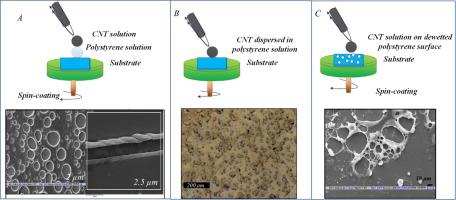Chemical Engineering Science ( IF 4.1 ) Pub Date : 2022-08-01 , DOI: 10.1016/j.ces.2022.117961 Surita Basu , Prabir Patra , Jayati Sarkar

|
In this article, we demonstrate how the instability of a polymeric thin film, when cast either as a mobile underlying support-layer of a bilayer assembly, as a mixture, or as a template, affects the self-assembly and arrangement of carbon nanotube (CNT) nanoparticles dispersed over/with it. The interplay of the different forces, like centrifugal, dewetting, Marangoni, electrostatic, assist the mobile nanoparticles in arranging themselves into circular ring-like structures. The congruence of the length scales of the self-assembled circular ring and the dewetted length scales of the thin polystyrene film reveals that the influence of dewetting dynamics is majorly responsible for the incipience of ring formations. However, the absence of coarsening and complete stoppage of movement of the rings towards the particulate region, reveals the presence of electrostatic repulsion. The nanoparticles not involved in circular-ring-self-assembly formation are driven by Marangoni force and engender nano-scratches over the polymeric surface. CNTs of smaller lengths deposit in the particulate zone where also, beyond a particular aspect ratio, the nanotubes are found to bend into circular rings. The bending of the carbon nanotubes is an energetically favored self-organization process controlled by the shape formation energy. When the underlying dewetted polystyrene surface acts as a template, the assembled CNT forms a circular ring-like interconnected relief structure. The circular rings of CNTs formed throughout the PS surface, fabricated by the dewetting of the mixture method, can be used to identify trace amounts of oil from an oil–water mixture by selective adsorption. The different self-assembled ring structures of CNTs are realized only for a specific concentration range of CNTs. The nanotubes assemble into random bundles/blobs devoid of any definite structures above this concentration.
中文翻译:

去湿辅助碳纳米管自组装成圆形纳米环
在本文中,我们展示了聚合物薄膜的不稳定性,无论是作为双层组件的移动底层支撑层、混合物还是模板,都会影响碳纳米管的自组装和排列。 CNT) 纳米颗粒分散在其上/与它一起。不同力的相互作用,如离心力、去湿力、马兰戈尼力、静电力,帮助可移动的纳米颗粒将自身排列成圆环状结构。自组装圆环的长度尺度与聚苯乙烯薄膜的去湿长度尺度的一致性表明,去湿动力学的影响是环形成开始的主要原因。然而,环没有变粗和完全停止向颗粒区域移动,揭示了静电排斥的存在。不参与圆环自组装形成的纳米粒子由 Marangoni 力驱动,并在聚合物表面产生纳米划痕。较小长度的 CNT 沉积在颗粒区域中,在该区域中,超过特定的纵横比,纳米管被发现弯曲成圆环。碳纳米管的弯曲是一种受形状形成能控制的能量有利的自组织过程。当下面的去湿聚苯乙烯表面作为模板时,组装的 CNT 形成圆形环状互连浮雕结构。通过混合方法的去湿法制造的在整个 PS 表面形成的 CNT 圆环可用于通过选择性吸附识别油水混合物中的痕量油。碳纳米管的不同自组装环结构仅在碳纳米管的特定浓度范围内实现。纳米管组装成随机的束/团,在该浓度之上没有任何确定的结构。











































 京公网安备 11010802027423号
京公网安备 11010802027423号